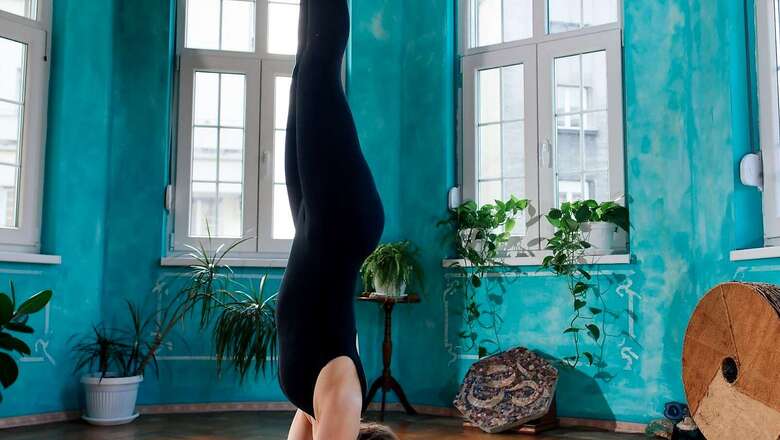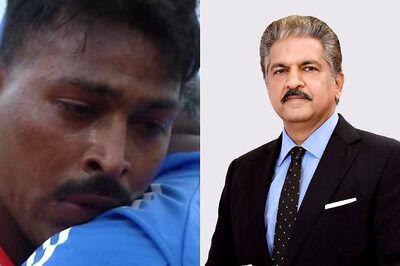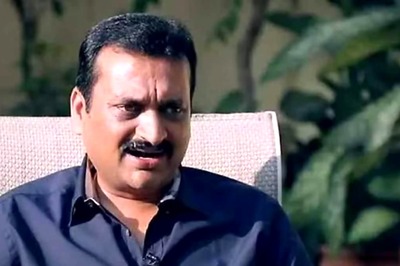
views
Every other Yoga class I have been to, and I have been to quite a few past eight years or so, has treated the headstand as something to be done by only those who know it. Know it how? Know it from earlier. But if no class teaches it, then how will I learn?
‘…and now whoever knows the headstand, please go into it, others can rest in child’s pose.’
This is what I have heard over and over in most Yoga classes. Not one to give up, I had then turned to the biggest Guru of our times. The Internet. And learned the headstand as taught by someone on a neon pink Yoga mat, wearing multicoloured tights – a far cry from the modestly attired and no-nonsense Krishna ji. Thanks to the internet expert, I also learned a new word, ‘tippytoe’. Kneel down, place your forearms on the mat and clasp your hands together. Place your head on the mat close to the palms, lift your hips up and then ‘tippytoe’ as close to your head as possible. Then leap or jump both legs up and place them on the wall. Inhale through the nose and breathe out through the mouth. And there you are – in headstand. […]
Cut to the Ashram.
‘If you are doing it with the wall, it is not headstand,’ is the first lesson I get when I hesitatingly ask if I can take wall support.
Leaping, jumping or kicking up is a big NO too, as is any form of breathing through the mouth.
‘You lose prana and energy if you breathe out through the mouth,’ we are cautioned. All breathing is through the nose.
The traditional Yoga way to do the headstand is scientific.
You sit in vajrasana, hold each elbow with alternate hands and measuring them out, place them in front of your knees. Then without lifting your elbows, you interlock your fingers and form a tripod with your arms and place the crown of your head on the mat, the anterior part fitting inside the cup of your hands. Straightening your knees, you lift your hips and go into the inverted V posture and then walk your feet forward – walk, not tippytoe – towards your head. Make sure the entire weight of the body is on the elbows. Once the hips are directly over the head, slowly lift both legs – do not jump or kick up – but do not straighten them. We use our abdominal and lumbar muscles here. First straighten the hips, keeping knees bent. Once you have ‘found your balance’ slowly straighten the legs. There are eight parts to go into the headstand. Yes, eight. And one needs to go through each one of them to ensure balance.
On the first day itself, I had understood the importance of the initial steps. Of measuring the elbows, making the tripod and placing the head within. This is the foundation created to establish the centre of gravity. I was always rubbish at Physics and my PCB score was mostly balanced by the C and B, the P not to be depended upon. But some concepts have stayed with me, bless Mrs Bannerji, our Physics teacher in school, centre of gravity being one of them.
When done with precision, following all steps, there is no reason you should not be able to do the headstand without support.
Only, I still could not.
In the good old days of extra class, Krishna ji would support me with her legs as I went up, being the ‘wall’ to my internet inspired attempts. At times she even held my legs for a few seconds, maybe in the hope that I would miraculously find my balance and not need the support; but when that did not happen as she expected it to, she withdrew the ‘support’ and left me to fall, fall and fall.
Each time I fell I would look at her, searching for sympathy, hoping that she would give me back the ‘wall’.
‘Is there a trick to it, Krishna ji? Something I can do…or if you can just hold me…?’
All I got in response was, ‘No there is no trick. You will have to find your balance Dahlia. It does not matter if you fall. Keep falling…until you get it.’
No sympathy. At all.
It is a wonder I have not broken my back. Yet. The number of times I have fallen from a headstand would be some sort of record, if anyone was keeping count. But it also goes to prove Krishna ji’s (and Maa’s) theory that our body isn’t as weak as we think it is. The regular Yoga practice is making my body stronger. […]
Since early this week we have started doing hip-opening asanas. Krishna ji warned us that these will lead to emotional meltdowns. And they have.
Apparently we store our emotional vulnerabilities in our hips, leading to their tightness. Seriously? Okay, this one I had no clue about. I knew about storing emotional stress in our neck and shoulder regions, and Krishna ji figured that one out right away the first time I attempted the headstand. But hips?
And the number of emotional meltdowns that the hip-opening exercises have brought about are testament to the fact that the hips are a major storehouse of our emotional baggage. The connection between body and mind is fascinating. Each day I am unravelling a new one, and I understand that it really is the mind that we are exercising here, not the body. Because only if the mind allows it will the body do it. I have ample proof of this being true.

Excerpted with permission from Ashramed: From Chaos to Calm by Dahlia Sen Oberoi, published by Hachette India, 2022.
Read all the Latest News , Breaking News , watch Top Videos and Live TV here.



















Comments
0 comment